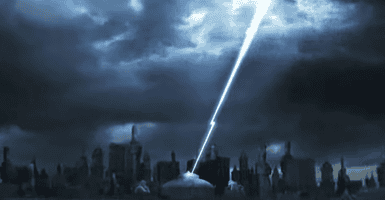Possible Earth-Like Planet May Possibly Be Hospitable. Possibly.
This article is more than 2 years old
When I was a kid, I used to love looking up at the stars through whatever telescope I could find. Eventually I stopped, because, like many other things in my life, I figured if I couldn’t see farther than anyone else, there wasn’t much of a point to it. This is obviously why I’m writing this story instead of the subject of it. Maybe there’s someone just like me on HD 40307 g. A team of researchers from the UK’s University of Hertfordshire Centre for Astrophysics Research, led by Mikko Tuomi, have located what may be a planet with life-sustaining similarities to our own.

To do this, they used the HARPS (High Accuracy Radial velocity Planet Searcher) on ESO’s (European Organization for Astronomical Research) La Silla 3.6m telescope, the sole purpose of which is to detect ridiculously minute star wobbles in order to find exoplanets. Lo and behold, the southern constellation Pictor, located 43 light-years from Earth, contains the orange dwarf star HD 40307, which has at least six super-Earth exoplanets hurtling through space around it.
The main candidate, “g,” is orbiting the star in its habitable zone, where it’s possible for liquid water to exist. The planet’s distance from the star is far enough so that it’s likely not tidally locked, meaning each side of the exoplanet isn’t singularly exposed to extreme climates, where one side faces only heat and radiation, while the side opposing the star stays dark and cold. Without this tidal lock, the climate and weather patterns would remain stable enough for comfortable habitation. Also, it’s estimated to be orbiting at 0.6 AU, and during it’s 200-day-long orbit, the 7-Earth-mass exoplanet gets hit with about 62% of the radiation the Sun blasts the Earth with.
Unfortunately, this is probably as far as the research can go with the current ground equipment. To gain any greater detail about the exoplanet, the team theorizes a direct imaging mission is key. The team’s paper will be published in the journal Astronomy & Astrophysics.
Another nifty fact gleaned from this discovery is that habitable planets can apparently form in solar systems different from our own, which was previously unknown. One researcher on the team, Guuillem Anglada-Escudé of Germany’s Universität Göttingen, created a video tour of the HD 40307 syystem using Celestia simulator, though it does not include the “g” planet. Watch it here.
This is probably the closest astronomers have come to a sure thing in the habitable planet department, though it’s hard for me to get excited about it just yet. Obviously, this will be great news to whatever line of great-grandchildren are around to make that trip. I expect it to look something like Airplane II.












